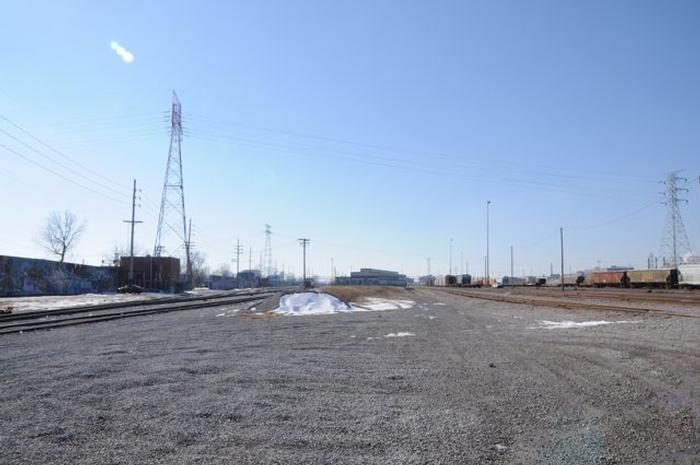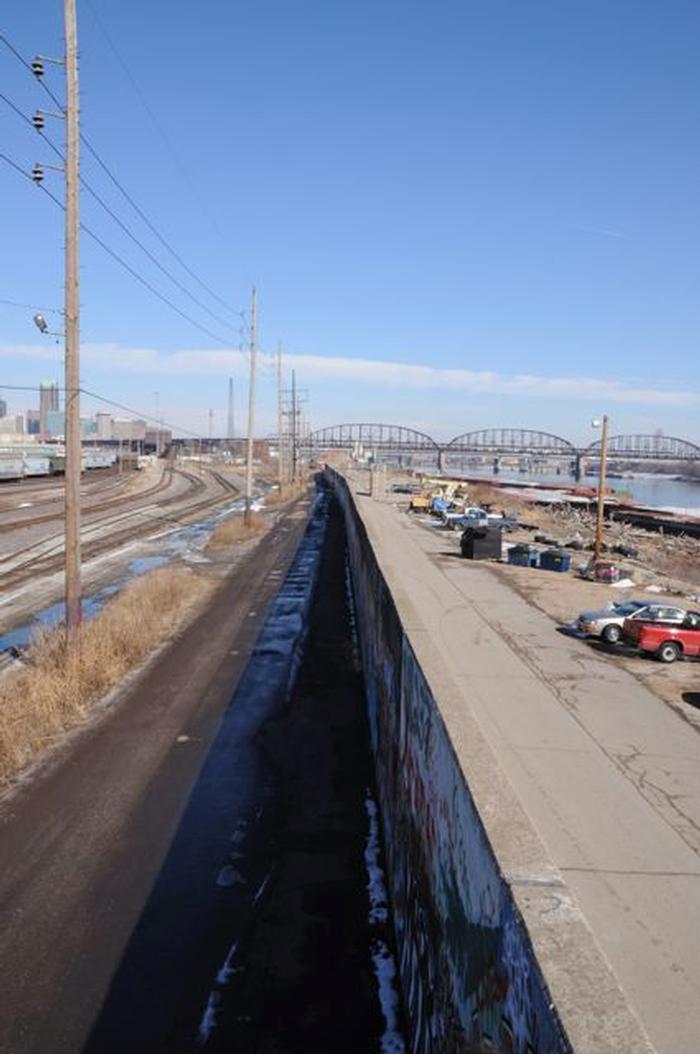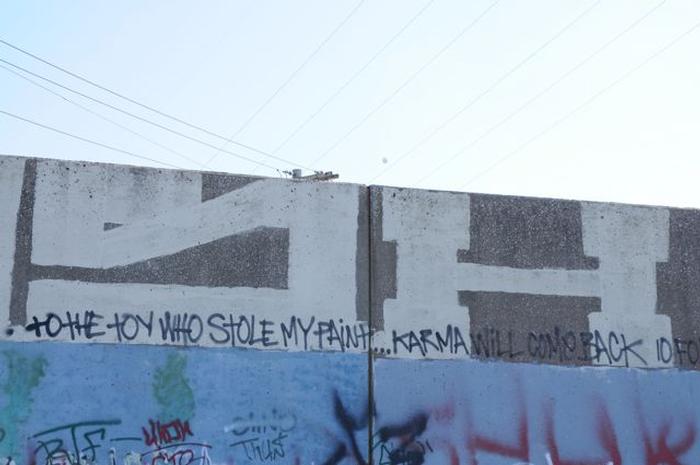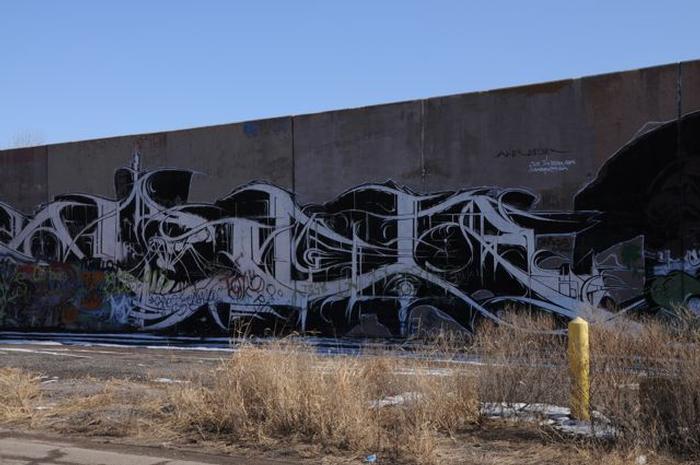[ID:47] A Wall Along the River: Fringe Graffiti in St. LouisUnited States St. Louis, Missouri rose in America as a result of the Mississippi River, and the river remains central to the city’s identity. Steamboats travelling south from Canada stopped in St. Louis, the last major port before New Orleans, Louisiana. Industry filled the flood banks of the river in the 19th century, and has remained long past the end of the Steamboat Era. Steamboats relied on the woods along the river’s banks, and as the forests dwindled, the Mississippi River widened. Floodwalls went into use at the absolute fringe. The city placed the barricades as close to the river as possible, for the greatest efficiency and the least disruption. From their inception, the floodwalls have existed on the perimeter of society. The majority of residents has no reason to visit the floodwalls since the area around the barricades consists of industrial or railroad traffic.
These walls have always had a connection to the graffiti scene in St. Louis. In a city publicly opposed to the spread of graffiti murals, the wall serves as one of the few surfaces in the city where this strict policy is not enforced. The city has forced the graffiti writers to the fringe both in terms of public acceptance and location. Although the city has ostracized the writers from its “core”, the city lacks the force necessary to completely eliminate the fringe group. As a result, the group reconstructs its identity around a new set of landmarks that define the geographic and social fringe, such as underpasses, industrial areas, and abandoned spaces.
An understanding of the floodwall’s sanctity begins when one realizes that the wall represents the graffiti group. “Sacred”, in this context, becomes an exclusive and limited quality. The group defines its values and beliefs outside of social norms, from which the city has expelled the fringe graffiti group. This experience parallels that of the floodwall; both the graffiti artists and the floodwall are seen by the city as burdensome, yet indestructible. St. Louis has never stipulated that the floodwall belongs to the graffiti group, yet the group would vehemently resist if, for example, the Boy Scouts of America turned the floodwall into a rock-climbing venue. In addition, if the graffiti community left St. Louis, the floodwall would no longer exist as a sacred space. If the entire St. Louis community saw the floodwall as more than a floodwall, then it would cease to be solely affiliated with the graffiti community and begin to represent the entire city. An example of this universal sanctity stands just north of the floodwall, St. Louis’ Gateway Arch. Eero Saarinen designed the Gateway Arch in 1947 as a massive monument to westward expansion. The Arch, technically a catenary curve, stands 630 feet tall and equally wide. The majority of the city bestows value on the Arch as an object worthy of representing the core community, due to the Arch’s monumental prominence in the city. The Gateway Arch gains status as a universally sacred object, even though residents in St. Louis county, nonpermanent residents, or fringe groups like the graffiti community might not agree with the Arch’s ability to represent contemporary St. Louis.
The renovated Arch grounds hope to attract visitors and residents with their expansive green spaces and improved Gateway-Arch experience. Most residents have only travelled up the Arch a handful of times and prefer to visit the nearby 1,293-acre Forest Park. Yet both Forest Park and the Arch grounds fail to communicate with the youth as directly as the floodwall might. These aged icons remember St. Louis’s historical heyday as the Nation’s fourth largest city, the site of the 1904 World’s Fair, and the traditional division between the Eastern and Western United States. These monumental qualities no longer address the youth of St. Louis; according to the 2000 US Census, St. Louis now ranks 18th in population size, and the United States has not hosted a World’s Fair since 1984 (New Orleans). Furthermore, in the age of jet travel where one can cross the country in roughly six hours, St. Louis hardly holds any psychological importance in the passage from East to West
The riverfront floodwall is twenty feet high, roughly thirty-six inches wide, and four miles long. It borders an area of sprawling industry, as shown in image 1. Railroad tracks run parallel to the floodwall. The two industrial fixtures, or sculptures, if one is inclined to think as such, form a channel that varies from 50 to 200 feet wide. The first 2 miles are completely covered in graffiti murals. The second half of the wall has received less attention; fewer artists move this far down the floodwall, and those who do produce less articulated work. This is likely because the latter half of the wall cannot be seen from the road or nearby highway, and graffiti artists favor highly visible or seemingly unreachable venues. A rough road runs the length of the floodwall, as seen in image 2. Though it is intended to serve the semi trucks moving between industrial sites, one commonly sees cars of tourists bumping down the path.
The murals become palimpsests as writers build up multiple layers of graffiti. The more prestigious pieces garner more respect from the group; it is considered very disrespectful to cover a recently completed mural with a juvenile “tag” or territorial scribble. To the graffiti community, the floodwall serves many roles: a meeting ground, a community board, a haven.The writers post messages to one another on the wall with frequency. They critique each other’s work, joke, and comment on the city. One such message left to another artists appears in Image 3. Without the floodwall, this group would have no capitol. This is a group that cannot meet in coffee houses or on university campuses to critique the work of peers. The graffiti community respects the riverfront floodwall as hallowed ground for the growth of the art form.
Dialogues of respect are extremely important within the graffiti group. Unskilled writers risk abuse if they alter an older writer’s piece or a piece that belongs to an established crew. A “crew” is a collection of writers who work together. If a member of a crew disrespects or is disrespected by another writer, the member expects the crew’s support. The willingness to defend certain graffiti works shows a hierarchy in graffiti design, and some method exists to judge graffiti value. The surface of the floodwall does have a large amount of trash graffiti, small tags or crude caricatures. This is due in part to the logistical issue that a mural takes much longer to complete, even longer if only one person is painting it. The shot of the wall in image 4 shows a complex mural and a multitude of inarticulate tags. This extreme range of quality on the wall suggests differing amounts of respect for the art of graffiti. The taggers have little desire to complete quality, large-scale murals. Instead, they prefer to quickly post a large quantity of tags. The taggers act as vandals; compared to the muralist’s work, the tags have little artistic quality and deteriorate the sacred space of the wall.
Although it is likely safe to assume that graffiti has been present on the riverfront floodwall since the 1980s, the first major gathering at the wall occurred in 1997. Large-scale conventions of graffiti artists are uncommon; information between graffiti “crews” spreads by word-of-mouth or by messages left on walls. A portion of the city’s writers met at the floodwall in August 1997 for the first “Underground Superfest”. Attendance was scant-- only two-dozen writers-- yet it set a precedent for meetings in 1998-2000. The inaugural “Paint Louis” occurred in 1998; the city sanctioned the festival and awarded permits to paint murals on the floodwall. The majority of the St. Louis muralists attended, no “toys,” or unskilled graffiti vandals, were given space along the floodwall. In 1999, Paint Louis exploded. The event hosted graffiti superstars from most major US cities and a few from the international community. In St. Louis, much of the city was galvanized for the event; the city and county populace travelled to the floodwall, many university students visited, and a local retirement home shuttled their residents in busses to the wall. The participation overwhelmed the volunteer staff assigned to issue paint, provide scaffolding, and clean the area. The city criticized the event organizers for poor planning, perhaps fairly, yet the organizers sought to redeem the event in 2000, after a large campaign to earn the permits to use the floodwall site.
2000 would mark the last year for Paint Louis. The event had attracted record crowds and boasted an even stronger national and international presence. However, few local artists participated, many of them losing spots along the floodwall to more prestigious painters. Along the floodwall, the organizers mobilized a large service crew dedicated to distributing supplies and policing the area. The organizers set rules for the painters: no painting on any surface other than the floodwall, only paint in your designated area, and do not leave trash. Despite this, graffiti vandalism spread outside of the floodwall area, mostly on garages and the nearby Shamrock Paper Company building. The public cried out against what business owners saw as a laissez-faire attitude towards graffiti vandalism, and the city cancelled Paint Louis in response. As of 2010, the muralist graffiti scene in St. Louis has remained on the fringe. The group has quieted, lacking any organizational system other than the floodwall.
To preserve the floodwall as a sacred space, it must be acknowledged in the impending redevelopment of the Riverfront Arch grounds. The winning group of the competition to redesign the riverfront will extend the green space surrounding the Arch. Their plan stops just north of the Floodwall, divided from the Arch by the elevated Interstate 64. The group, MVVA Team, wishes to attract greater numbers to the Arch grounds with event spaces, concerts, and commercial attractions. If this occurs, it will be impossible for visitors not to notice the massive floodwall resplendent with murals. Rather than ignore the wall, the city should welcome the site for its immense cultural and artistic significance.
I propose that the initial 1.4 miles of the riverfront floodwall be converted into a monitored site for the advancement of graffiti and street art. The site would be brightly lit, and the dirt road paved. A permanent staff, ideally members of the graffiti scene themselves, will work with local law enforcement to police the area, keep visitors safe, and maintain the site. Visitors will park at the Arch front’s proposed south parking garage and use a series of designated walkways to view the art. The site would be open during the day and evening. In order to paint on the wall, graffiti muralists will register for sections of the wall. With nearly a mile and a half of wall space, and a changing lineup of artists on the wall, I believe there will always be open spaces. Floodwall organizers will record the artist’s personal information, such as name, address, and contact information as well as the artist’s graffiti moniker. Artists usually keep these names secret because it can link them to illegal graffiti. If the wall is sanctioned as a legal zone for graffiti, and the names are kept confidential, then it will harm the graffiti artists to disclose their identities. In this way, the city will enter into a respectful relationship with graffiti artists. The artist gains control of a free, outdoor gallery space with a steady audience of visitors and peers, and the city can better respond to vandalism through the development of a graffiti-writer database.
The space will be preserved as a distinctly sacred space for the graffiti fringe group. In this way, the core group can accept the portion of the graffiti group concerned with graffiti as an art form. The site will also have the double-edged effect of further ostracizing the vandals of the graffiti scene, as if clarifying from the fringe group the portion that does not wish to associate with illegal activities. This part of the fringe group will gain a measure of acceptance by the city; while many may still not accept graffiti as art, the wall will help to sever the historic connection between graffiti and illegality. Certainly some of the city will accept the graffiti artists as contributors to the core group, thus opening the opportunity for commercial success. This development will also make the site more available to artists; crews or individuals can work during the day with scaffolds, better lighting, and in the company of other artists. In a city with shockingly few venues for young artists, the floodwall will gain respect as the preeminent site for contemporary and counterculture artwork.
Many have criticized legal-graffiti murals. The key issues correlate with the concerns of Paint Louis: the fringe group of graffiti artists refuses to adhere to designated areas and pollute the surrounding area with trash and vandalism. Programs in Huntington Beach, Venice Beach, and San Francisco shut down because graffiti quickly bled into the surrounding community. These projects failed because they did not address the ideology of the graffiti community, causing the fringe group to rebel against the core group’s attempt at control. In these instances, the core group was composed of a community or neighborhood committee in search of a way to beautify an existing wall in the immediate area. The core crucially failed to disassociate themselves from the “establishment” and instead set rules for the graffiti artists. The artists rejected the neighborhood’s attempt to control their art form. Additionally, none of the committees formed any kind of permanent or semi-permanent maintenance program. Each had a laissez faire attitude towards the graffiti artists and seemed keen on maintaining distance between their core group and the fringe group.
In order for a legalized graffiti site to meet the wants of the city of St. Louis, we must respect the desires of the graffiti community, a group that sees the floodwall as a sacred facet of their identity. The proposed site will in effect expose this underground element, yet we must diligently resist commodifying the art along the floodwall. The “top-down” design strategy employed in California will only alienate the fringe group. Instead, we should first respect the graffiti scene as a part of the larger network of communities. This means the right to free expression and the right to congregate along the floodwall. We should encourage the group to be self-governing, so that the dialogues of respect towards art transmit into respect for the community. In doing so, we will assuage the city’s fears of unmitigated vandalism. The city will develop a less murky attitude towards graffiti by allowing the art form while excluding the vandals. The fringe group, once banished from the rest of the city, will split along this line, and a large portion will gain the rights that had been withheld from them. The sanctity of the riverfront floodwall, once so limited, can in this way come to represent more of St. Louis.
If you would like to contact this author, please send a request to info@berkeleyprize.org. |




